Abstract
OBJECTIVE--To investigate whether bacteriuria and, specifically, symptomatic urinary tract infection (UTI) occur with increased frequency in men with HIV infection. METHODS--In this cross-sectional study we investigated three groups of men, aged from 18 to 50 years. Group A was composed of patients with a diagnosis of AIDS; Group B, of patients without HIV infection, and group C of patients with asymptomatic HIV infection. Patients with any known predisposing factor for UTI were excluded from the study. A clean-catch midstream urine sample was collected from each patient on the first day of hospital admission (groups A and B) or during a visit to the outpatient clinic (group C). Bacteriuria was diagnosed when > or = 100,000 colony forming units/ml, urine were grown. RESULTS--There were 415 patients, 151 in group A, 170 in group B and 94 in group C. Bacteriuria was significantly more frequently in group A (20 cases, 13.3%) than in groups B (3 cases, 1.8%, p = 0.00007) and C (3 cases, 3.2%, p = 0.009). Ten cases of bacteriuria in group A (6.6%) were symptomatic while no case of symptomatic UTI was seen in groups B (p = 0.0004) and C (p = 0.008). The frequency of UTI in homosexual men with AIDS (7 cases, 6.7%) was not significantly different from that observed in men with AIDS who denied homosexuality (3 cases, 6.5%). E coli was the predominant pathogen associated with UTI. Although adequate response to a two-week course of antibiotics was observed in most cases, an in-hospital mortality rate of 20% was found among AIDS patients with symptomatic UTI. CONCLUSIONS--In the present study, the frequency of bacteriuria and symptomatic UTI was found to be increased in men with AIDS. E coli was the predominant pathogen in these cases. These data suggest that symptomatic UTI may represent a relevant cause of morbidity for men with AIDS.
Full text
PDF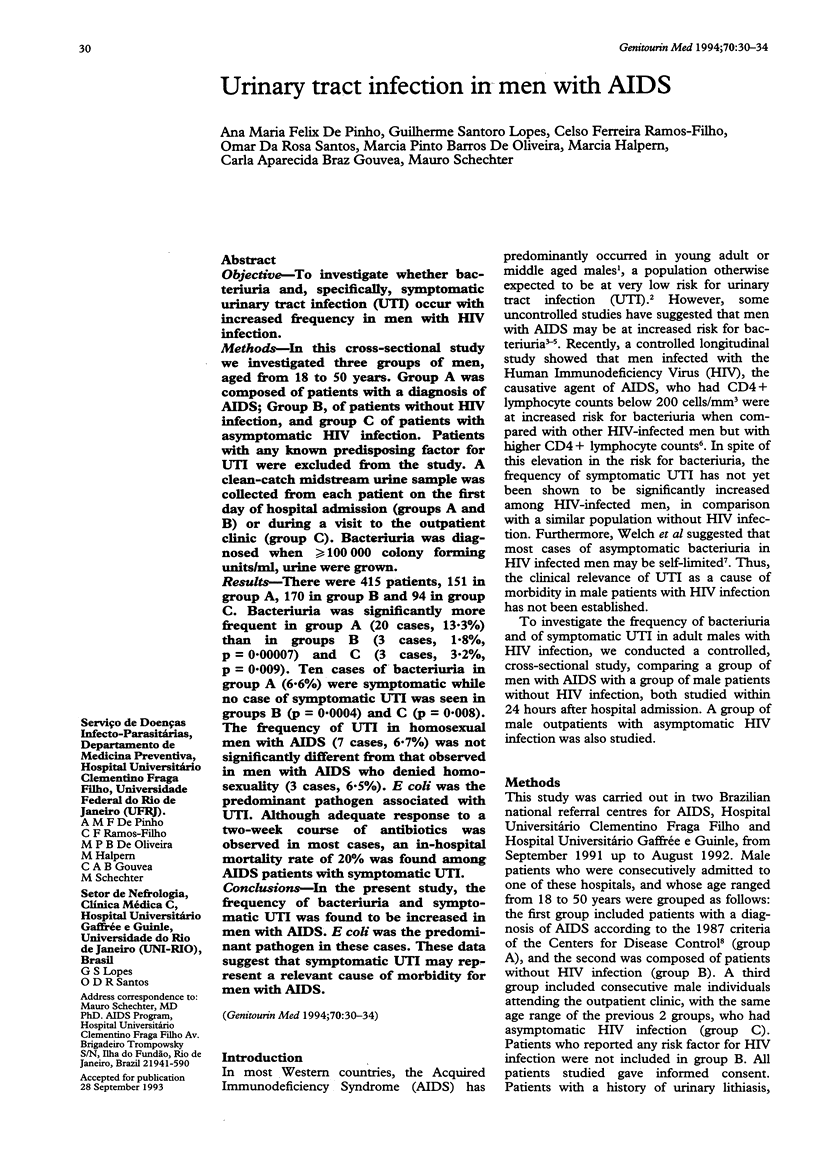
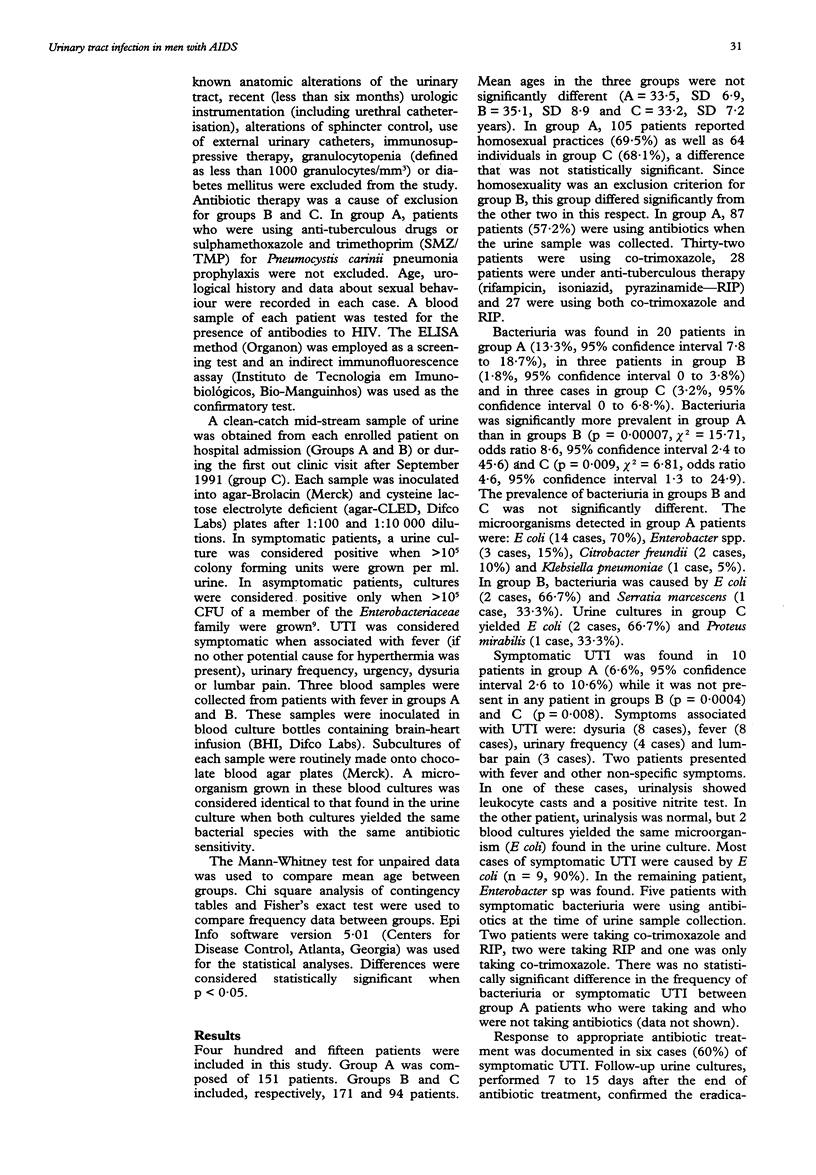
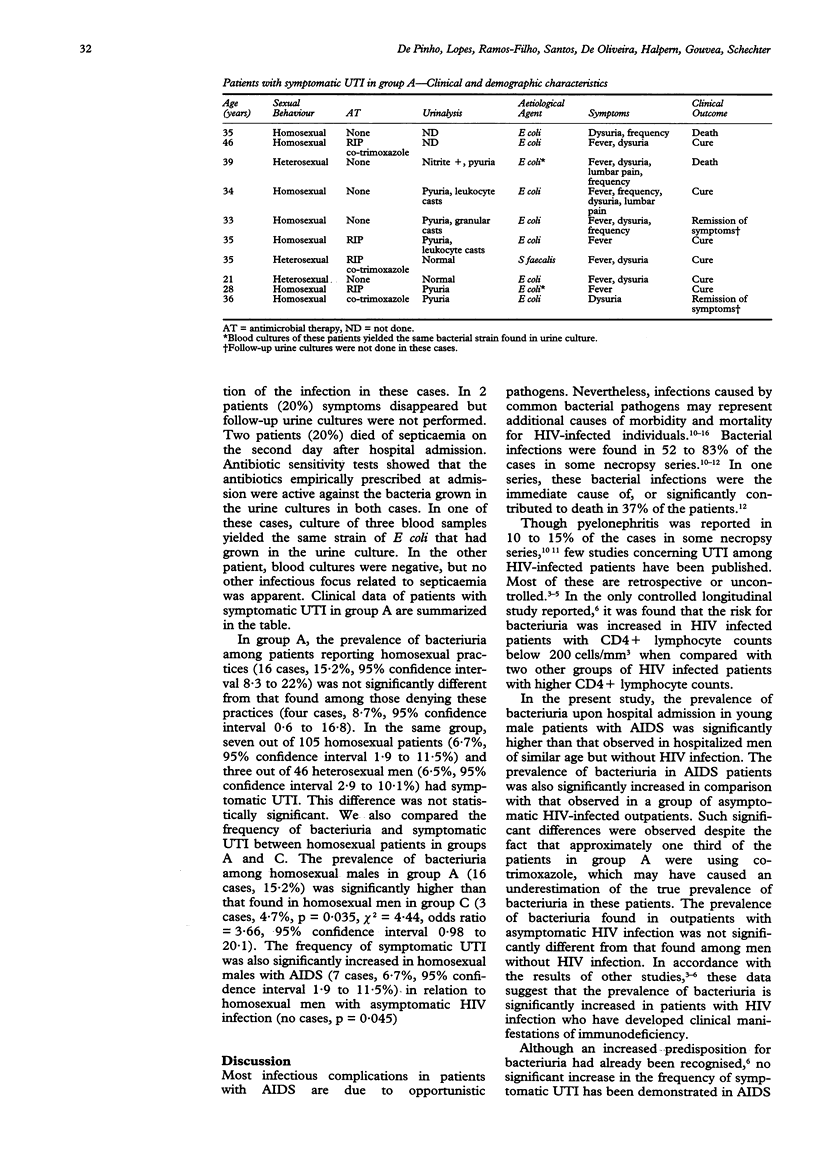
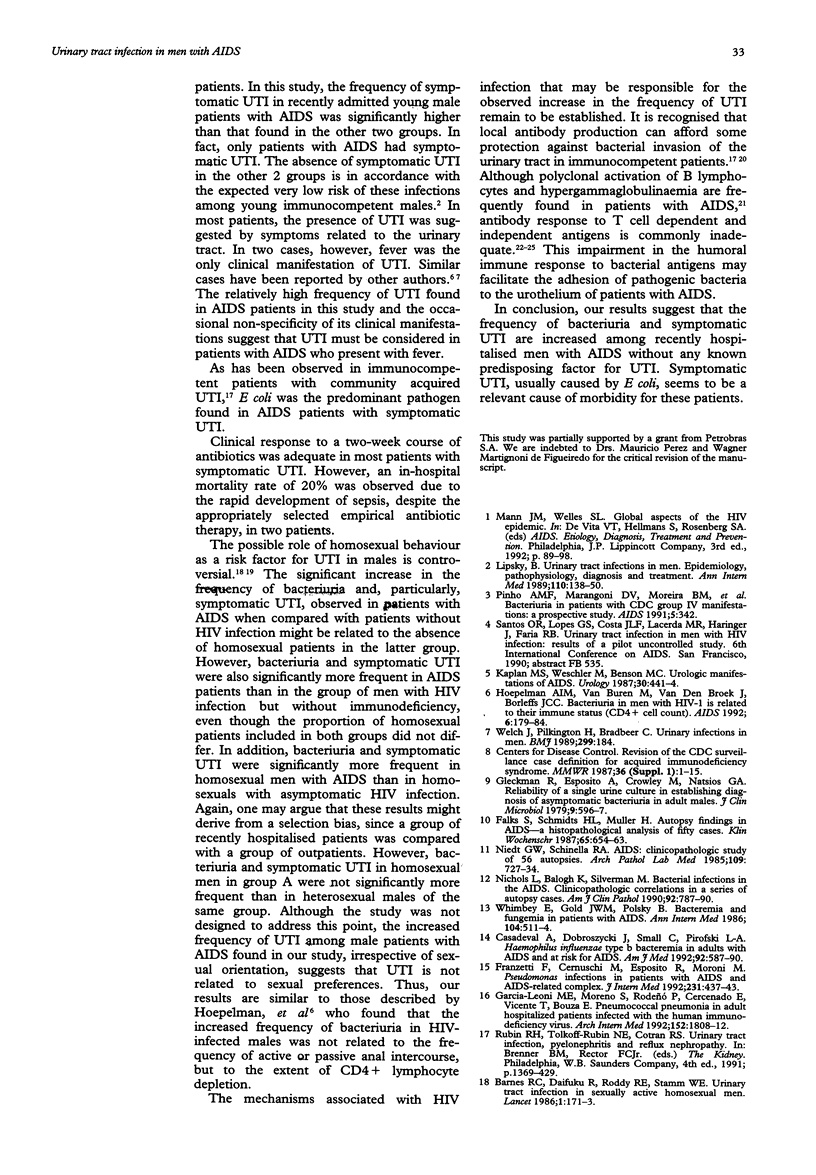
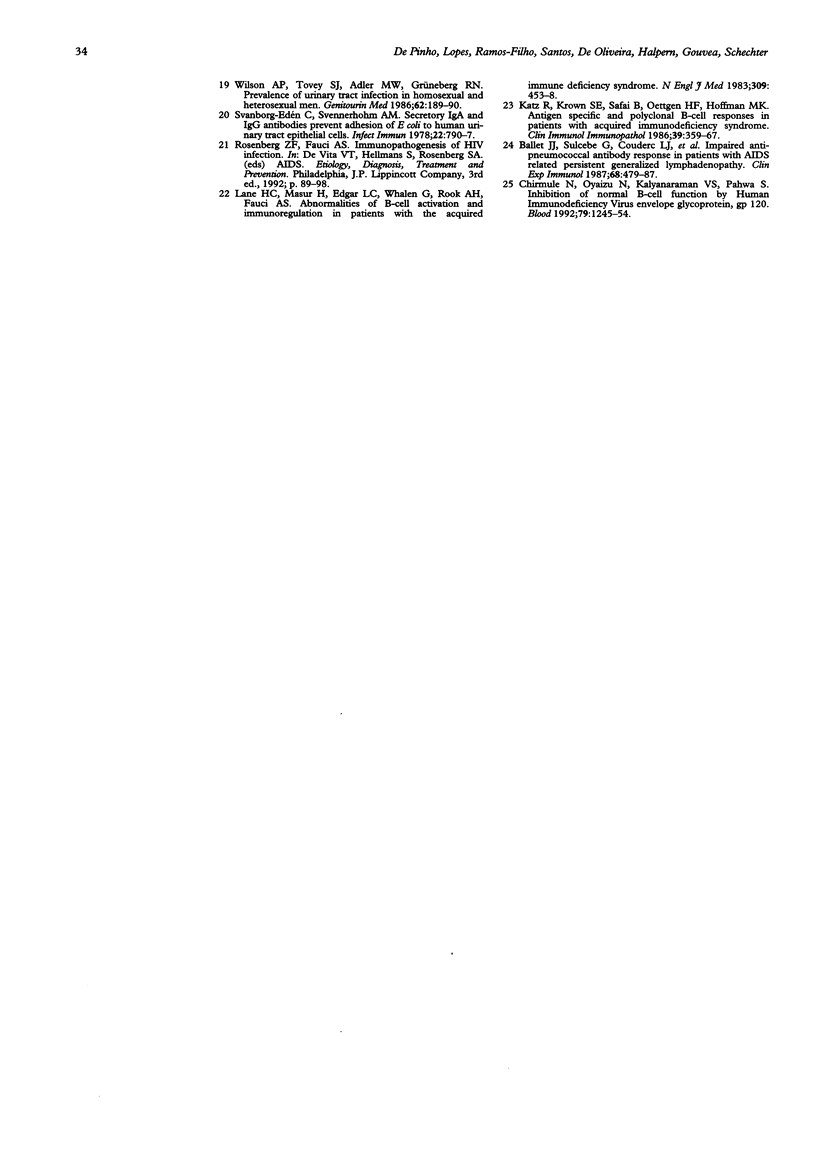
Selected References
These references are in PubMed. This may not be the complete list of references from this article.
- Ballet J. J., Sulcebe G., Couderc L. J., Danon F., Rabian C., Lathrop M., Clauvel J. P., Seligmann M. Impaired anti-pneumococcal antibody response in patients with AIDS-related persistent generalized lymphadenopathy. Clin Exp Immunol. 1987 Jun;68(3):479–487. [PMC free article] [PubMed] [Google Scholar]
- Barnes R. C., Daifuku R., Roddy R. E., Stamm W. E. Urinary-tract infection in sexually active homosexual men. Lancet. 1986 Jan 25;1(8474):171–173. doi: 10.1016/s0140-6736(86)90650-1. [DOI] [PubMed] [Google Scholar]
- Casadevall A., Dobroszycki J., Small C., Pirofski L. A. Haemophilus influenzae type b bacteremia in adults with AIDS and at risk for AIDS. Am J Med. 1992 Jun;92(6):587–590. doi: 10.1016/0002-9343(92)90774-6. [DOI] [PubMed] [Google Scholar]
- Chirmule N., Oyaizu N., Kalyanaraman V. S., Pahwa S. Inhibition of normal B-cell function by human immunodeficiency virus envelope glycoprotein, gp120. Blood. 1992 Mar 1;79(5):1245–1254. [PubMed] [Google Scholar]
- Falk S., Schmidts H. L., Müller H., Berger K., Schneider M., Schlote W., Helm E. B., Stille W., Hübner K., Stutte H. J. Autopsy findings in AIDS--a histopathological analysis of fifty cases. Klin Wochenschr. 1987 Jul 15;65(14):654–663. doi: 10.1007/BF01875500. [DOI] [PubMed] [Google Scholar]
- Franzetti F., Cernuschi M., Esposito R., Moroni M. Pseudomonas infections in patients with AIDS and AIDS-related complex. J Intern Med. 1992 Apr;231(4):437–443. doi: 10.1111/j.1365-2796.1992.tb00957.x. [DOI] [PubMed] [Google Scholar]
- García-Leoni M. E., Moreno S., Rodeñ P., Cercenado E., Vicente T., Bouza E. Pneumococcal pneumonia in adult hospitalized patients infected with the human immunodeficiency virus. Arch Intern Med. 1992 Sep;152(9):1808–1812. doi: 10.1001/archinte.1992.00400210040007. [DOI] [PubMed] [Google Scholar]
- Gleckman R., Esposito A., Crowley M., Natsios G. A. Reliability of a single urine culture in establishing diagnosis of asymptomatic bacteriuria in adult males. J Clin Microbiol. 1979 May;9(5):596–597. doi: 10.1128/jcm.9.5.596-597.1979. [DOI] [PMC free article] [PubMed] [Google Scholar]
- Hoepelman A. I., van Buren M., van den Broek J., Borleffs J. C. Bacteriuria in men infected with HIV-1 is related to their immune status (CD4+ cell count). AIDS. 1992 Feb;6(2):179–184. doi: 10.1097/00002030-199202000-00006. [DOI] [PubMed] [Google Scholar]
- Kaplan M. S., Wechsler M., Benson M. C. Urologic manifestations of AIDS. Urology. 1987 Nov;30(5):441–443. doi: 10.1016/0090-4295(87)90375-x. [DOI] [PubMed] [Google Scholar]
- Katz I. R., Krown S. E., Safai B., Oettgen H. F., Hoffmann M. K. Antigen-specific and polyclonal B-cell responses in patients with acquired immunodeficiency disease syndrome. Clin Immunol Immunopathol. 1986 Jun;39(3):359–367. doi: 10.1016/0090-1229(86)90164-9. [DOI] [PubMed] [Google Scholar]
- Lane H. C., Masur H., Edgar L. C., Whalen G., Rook A. H., Fauci A. S. Abnormalities of B-cell activation and immunoregulation in patients with the acquired immunodeficiency syndrome. N Engl J Med. 1983 Aug 25;309(8):453–458. doi: 10.1056/NEJM198308253090803. [DOI] [PubMed] [Google Scholar]
- Lipsky B. A. Urinary tract infections in men. Epidemiology, pathophysiology, diagnosis, and treatment. Ann Intern Med. 1989 Jan 15;110(2):138–150. doi: 10.7326/0003-4819-110-2-138. [DOI] [PubMed] [Google Scholar]
- Nichols L., Balogh K., Silverman M. Bacterial infections in the acquired immune deficiency syndrome. Clinicopathologic correlations in a series of autopsy cases. Am J Clin Pathol. 1989 Dec;92(6):787–790. doi: 10.1093/ajcp/92.6.787. [DOI] [PubMed] [Google Scholar]
- Niedt G. W., Schinella R. A. Acquired immunodeficiency syndrome. Clinicopathologic study of 56 autopsies. Arch Pathol Lab Med. 1985 Aug;109(8):727–734. [PubMed] [Google Scholar]
- Pinho A. M., Maranconi D. V., Moreira B. M., Rodrigues K. M., Paz N. A., Ramos-Filho C. F., Schechter M. Bacteriuria in patients with CDC group IV manifestations: a prospective study. AIDS. 1991 Mar;5(3):342–342. [PubMed] [Google Scholar]
- Svanborg-Edén C., Svennerholm A. M. Secretory immunoglobulin A and G antibodies prevent adhesion of Escherichia coli to human urinary tract epithelial cells. Infect Immun. 1978 Dec;22(3):790–797. doi: 10.1128/iai.22.3.790-797.1978. [DOI] [PMC free article] [PubMed] [Google Scholar]
- Welch I., Pilkington H., Bradbeer C. Urinary tract infections in men. BMJ. 1989 Jul 15;299(6692):184–184. doi: 10.1136/bmj.299.6692.184. [DOI] [PMC free article] [PubMed] [Google Scholar]
- Whimbey E., Gold J. W., Polsky B., Dryjanski J., Hawkins C., Blevins A., Brannon P., Kiehn T. E., Brown A. E., Armstrong D. Bacteremia and fungemia in patients with the acquired immunodeficiency syndrome. Ann Intern Med. 1986 Apr;104(4):511–514. doi: 10.7326/0003-4819-104-4-511. [DOI] [PubMed] [Google Scholar]
- Wilson A. P., Tovey S. J., Adler M. W., Grüneberg R. N. Prevalence of urinary tract infection in homosexual and heterosexual men. Genitourin Med. 1986 Jun;62(3):189–190. doi: 10.1136/sti.62.3.189. [DOI] [PMC free article] [PubMed] [Google Scholar]


